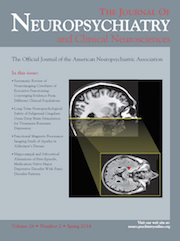Functional Magnetic Resonance Imaging Study of Apathy in Alzheimer’s Disease
Abstract
An fMRI study was launched to understand mechanisms of Alzheimer’s disease (AD) patients with apathy. The authors reviewed seven AD patients with apathy and six AD patients without apathy. The block method was adopted, and 24 pictures representing positive, negative, and neutral emotional stimuli were viewed when patients were given brain fMRI. Under “sad versus neutral” stimulation, non-apathetic AD patients had increased activity in bilateral amygdala and bilateral fusiform gyrus, whereas apathetic AD patients only had increased activities in bilateral fusiform gyrus. Thus, the amygdala was the possible anatomical structure related to apathy in AD patients.



